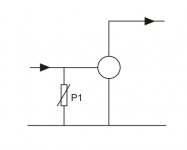2015 and the signal still goes through a pot for volume controlling in almost all analog circuits.
How god is this fot the SQ is a sensitive question, but people pay up to $240 for a Khozmo, Dact; Alps or you name it. Those DLR guys swear to gods and devils, it is the best they have heard.
Is that really needed? Why can't we do this way? Or how can we do it? A Volume Controlling Buffer.
How god is this fot the SQ is a sensitive question, but people pay up to $240 for a Khozmo, Dact; Alps or you name it. Those DLR guys swear to gods and devils, it is the best they have heard.
Is that really needed? Why can't we do this way? Or how can we do it? A Volume Controlling Buffer.
Attachments
2015 and the signal still goes through a pot for volume controlling in almost all analog circuits.
How god is this fot the SQ is a sensitive question, but people pay up to for a Khozmo, Dact; Alps or you name it. Those DLR guys swear to gods and devils, it is the best they have heard.
Is that really needed? Why can't we do this way? Or how can we do it? A Volume Controlling Buffer.
Which pretty much is what the B1 is.
An easier option if you have a digital source is to use digital volume management. As long as you can ensure that your gain structure is decent then it performs better, is easier and far more cheap =)
In the case of the B1 I was looking for neutrality. The LDR designs (including
my own) generate significant 2nd and/or 3rd harmonic. Nothing wrong with
that if that's what you want.
You seem to have an a priori objection to a pot, perhaps because you
don't trust the wiper.
I deal with that issue by using good sealed pots and by having the wiper see
a high impedance load.
Honestly, I don't have an interest in pursuing the volume control thing further -
too many power amps remain unbuilt.

my own) generate significant 2nd and/or 3rd harmonic. Nothing wrong with
that if that's what you want.
You seem to have an a priori objection to a pot, perhaps because you
don't trust the wiper.
I deal with that issue by using good sealed pots and by having the wiper see
a high impedance load.
Honestly, I don't have an interest in pursuing the volume control thing further -
too many power amps remain unbuilt.
2015 and the signal still goes through a pot for volume controlling Why can't we do this way?
In most circuits, the analog of the signal is a voltage. A voltage attenuator requires a series resistance as well as a shunt resistance.
Both resistances are equally important. The shunt resistance is not less critical because the idea that the signal "doesn't go through it" is wrong.
The input characteristics of the following circuit are very important, since they load the attenuator and change its performance.
Switched high quality resistors are much better than any pot for analog volume control.
Last edited:
Member
Joined 2009
Paid Member
Thank you Mr. Pass for looking in. I love the concept of B1.
And what means "using good sealed pots and by having the wiper see a high impedance load" how? any explanation please?
If you can find pots that are Military spec (Milspec), these almost always are sealed completely from the environment and not prone to gathering dirt/soot/grease from the air around them. Less quality pots are often not sealed and can degrade over time. Many of the MILspec pots are in the higher wattage ranges (one watt or above). I have some that are over thirty years old and still work well.
The part about pots working into a high impedance is what is accomplished by the active part of the B1 design. The input impedance of the dual JFET circuit is considered high impedance. I hope this helps.

Resistance!
Thanks but my major concern is resistance!
Every time I remove a resistor from signal path, it will be a progress in sound quality. Even branded ones such PRP or Vishay MBB!
I use a stepped attenuator with PRP/Holco resistors. The last step is shortage. A major difference between the "next to last, 10 ohm" and "last step" with no resistor! strange?
That's why I am looking for a Volume controlling Buffer.
Thanks but my major concern is resistance!
Every time I remove a resistor from signal path, it will be a progress in sound quality. Even branded ones such PRP or Vishay MBB!
I use a stepped attenuator with PRP/Holco resistors. The last step is shortage. A major difference between the "next to last, 10 ohm" and "last step" with no resistor! strange?
That's why I am looking for a Volume controlling Buffer.
my major concern is resistance! Every time I remove a resistor from signal path, it will be a progress in sound quality.
That's why I am looking for a Volume controlling Buffer.
The gain of such a buffer is controlled by resistors directly IN the signal path, usually in the nfb loop.
Such resistors are not in a separate "control circuit" like in a voltage controlled amplifier.
- Status
- This old topic is closed. If you want to reopen this topic, contact a moderator using the "Report Post" button.
- Home
- Amplifiers
- Pass Labs
- Is it that impossible?
